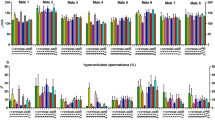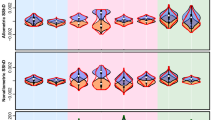Abstract
The major histocompatibility complex (MHC) is a source of unique individual odors that influence individual recognition, mating preferences, nesting behavior and selective block of pregnancy in animals1,2,3,4,5,6,7,8,9,10. Such phenomena have been difficult to study in humans, because the human leukocyte antigen (HLA, human MHC) loci are the most polymorphic loci in the human genome11, with the potential to generate millions of unique combinations of genotypes. In addition, high variability in background odors, encoded by the rest of the genome and influenced by cultural practices, contribute to a low signal-to-noise ratio that could mask HLA-based olfactory cues. Here we show that women can detect differences of one HLA allele among male odor donors with different MHC genotypes. Notably, the mechanism for a woman's ability to discriminate and choose odors is based on HLA alleles inherited from her father but not her mother. The parents' HLA alleles that she does not inherit show no relationship with odor choice, despite exposure to these HLA-encoded odors throughout her life. Our data indicate that paternally inherited HLA-associated odors influence odor preference and may serve as social cues.
This is a preview of subscription content, access via your institution
Access options
Subscribe to this journal
Receive 12 print issues and online access
$209.00 per year
only $17.42 per issue
Buy this article
- Purchase on Springer Link
- Instant access to full article PDF
Prices may be subject to local taxes which are calculated during checkout



Similar content being viewed by others
References
Yamazaki, K. et al. Recognition among mice: evidence from the use of a Y-maze differentially scented by congenic mice of different major histocompatibility types. J. Exp. Med. 150, 755–760 (1979).
Yamaguchi, M. et al. Distinctive urinary odors governed by the major histocompatibility complex. Proc. Natl Acad. Sci. USA 78, 5817–5820 (1981).
Beauchamp, G.K. et al. Chemosensory recognition of mouse major histocompatibility types by another species. Proc. Natl Acad. Sci. USA 82, 4186–4188 (1985).
Yamazaki, K. et al. Control of mating preferences in mice by genes in the major histocompatibility complex. J. Exp. Med. 144, 1324–1335 (1976).
Yamazaki, K. et al. Recognition of H-2 types in relation to the blocking of pregnancy in mice. Science 221, 186–188 (1983).
Brown, R.E., Singh, P.B. & Roser, B. The major histocompatibility complex and the chemosensory recognition of individuality in rats. Physiol. Behav. 40, 65–73 (1986).
Egid, K. & Brown, J.L. The major histocompatibility complex and female mating preferences in mice. Anim. Behav. 38, 4186–4188 (1989).
Eklund, A., Egid, K. & Brown, J.L. The major histocompatibility complex and mating preferences of male mice. Anim. Behav. 42, 693–694 (1991).
Potts, W.K., Manning, C.J. & Wakeland, E.K. Mating patterns in seminatural populations of mice influenced by MHC genotype. Nature 352, 619–621 (1991).
Manning, C.J., Wakeland, E.K. & Potts, W.K. Communal nesting patterns in mice implicate MHC genes in kin recognition. Nature 360, 581–583 (1992).
Parham, P. & Ohta, T. Population biology of antigen presentation by MHC class I molecules. Science 272, 67–74 (1996).
Herrick, C.J. Neurological Foundations of Behavior (Holt, New York, 1924).
Schaal, B. & Porter, R.H. “Microsmatic humans” revisited: the generation and perception of chemical signals. Adv. Study Behav. 20, 135–199 (1991).
Devos, M., Patte, F., Rouault, J., Laffort, P. & Van Gemert, L.J. Standardized Human Olfactory Thresholds (IRL Press at Oxford University Press, Oxford, 1990).
Gilbert, A.N., Yamazaki, K., Beauchamp, G.K. & Thomas, L. Olfactory discrimination of mouse strains (Mus musculus) and major histocompatibility types by humans (Homo sapiens). J. Comp. Psychol. 100, 262–265 (1986).
Wedekind, C., Seebeck, T., Bettens, F. & Paepke, A.J. MHC-dependent mate preferences in humans. Proc. R Soc. Lond. B 260, 245–249 (1995).
Wedekind, C. & Füri, S. Body odour preferences in men and women: do they aim for specific MHC combinations or simply heterozygosity? Proc. R Soc. Lond. B 264, 1471–1479 (1997).
Quadagno, D.M. & Banks, E.M. The effect of reciprocal cross-fostering on the behaviour of two species of rodents, Mus musculus and Baiomys taylori ater. Anim. Behav. 18, 379–390 (1970).
McCarthy, R. & Southwick, C.H. Cross-species fostering: effects on the olfactory preferences of onychoms torridus and Peromyscus leucopus. Behav. Biol. 19, 255–260 (1977).
Yamazaki, K., Beauchamp, G.K., Kupniewski, D., Bard, J. & Thomas, L. Familial imprinting determines H-2 selective mating preferences. Science 240, 1331–1332 (1988).
Ober, C. et al. HLA and mate choice in humans. Am. J. Hum. Genet. 61, 497–504 (1997).
Weitkamp, L.R. & Ober, C. Ancestral and recombinant 16-locus HLA haplotypes in the Hutterites. Immunogenetics 49, 491–497 (1999).
Pause, B.M., Sojka, B., Krauel, K., Fehm-Wolfsdorf, G. & Ferstl, R. Olfactory information processing during the course of the menstrual cycle. Biol. Psychol. 44, 31–54 (1996).
Ober, C., Weitkamp, L.R. & Cox, N. in Chemical Signals in Vertebrates 8 (eds Johnston, R., Müller-Schwarz, D. & Sorensen, P.) 189–199 (Plenum, New York, 1999).
Berridge, K.C. & Robinson, T.E. What is the role of dopamine in reward: hedonic impact, reward learning, or incentive salience? Brain Res. Rev. 28, 309–369 (1998).
Gilder, P.M. & Slater, P.J. Interest of mice in conspecific male odours is influenced by degree of kinship. Nature 274, 364–365 (1978).
Bateson, P. in Mate Choice (ed. Bateson, P.) 257–277 (Cambridge University Press, Cambridge, 1983).
Ochoa, G. & Jaffe, K. On sex, mate selection and the Red Queen. J. Theor. Biol. 199, 1–9 (1999).
Penn, J.P. & Potts, W.K. The evolution of mating preferences and major histocompatibility genes. Am. Nat. 153, 145–164 (1999).
Smith, K. in Department of Psychology 167 (The University of Chicago, Chicago, 2000).
Schaefer, M.L., Young, D.A. & Restrepo, D. Olfactory fingerprints for major histocompatibility complex-determined body odors. J. Neurosci. 21, 2481–2487 (2001).
Mori, K., Nagao, H. & Yoshihara, Y. The olfactory bulb: coding and processing of odor molecule information. Science 286, 711–715 (1999).
Fan, W., Weiwen, C., Parimoo, S., Lennon, G.G. & Weissman, S.M. Identification of seven new MHC class I region genes around the HLA-F locus. Immunogenetics 44, 97–103 (1996).
Amadou, C. et al. The mouse major histocompatibility complex: some assembly required. Immunol. Rev. 167, 211–221 (1999).
Yamazaki, K., Singer, A., Curran, M. & Beauchamp, G.K. in Chemical Signals in Vertebrates Vol. 8 (eds Johnston, R.E., Muller-Schwarze, D. & Sorenson, P.W.) 173–180 (Plenum, New York, 1999).
Vincent, C. & Revillard, J.P. Characterization of molecules bearing HLA determinants in serum and urine. Tranplant. Proc. 11, 1301–1302 (1979).
Pearse-Pratt, R., Schellinck, H., Brown, R., Singh, P.B. & Roser, B. Soluble MHC antigens and olfactory recognition of genetic individuality: the mechanism. Genetica 104, 223–230 (1999).
Isles, A.R., Baum, M.J., Ma, D., Keverne, E.B. & Allen, N.D. Urinary odour preferences in mice. Nature 409, 783–784 (2001).
Acknowledgements
We thank D. Hayreh and P. Klimczyk for assistance on field trips, K. Beaman for serological HLA typing the donors in this study, C. Wedekind for sharing unpublished protocols and J. Brown for helpful comments. This work was supported by a MERIT Award from the National Institute of Mental Health, a grant from the John T. and Catherine D. MacArthur Foundation (to M.K.M.), a grant from the National Institute of Child Health and Development (to C.O.) and an MD/PhD Training Grant from the National Institutes of Health (to S.J.).
Author information
Authors and Affiliations
Corresponding author
Rights and permissions
About this article
Cite this article
Jacob, S., McClintock, M., Zelano, B. et al. Paternally inherited HLA alleles are associated with women's choice of male odor. Nat Genet 30, 175–179 (2002). https://doi.org/10.1038/ng830
Received:
Accepted:
Published:
Issue Date:
DOI: https://doi.org/10.1038/ng830
This article is cited by
-
The scent of attraction and the smell of success: crossmodal influences on person perception
Cognitive Research: Principles and Implications (2021)
-
Olfactory signals and fertility in olive baboons
Scientific Reports (2021)
-
Chemical profiling of volatile organic compounds from shoe odour for personal identification
Egyptian Journal of Forensic Sciences (2020)
-
Gamete-level immunogenetic incompatibility in humans–towards deeper understanding of fertilization and infertility?
Heredity (2020)
-
Altered responses to social chemosignals in autism spectrum disorder
Nature Neuroscience (2018)



